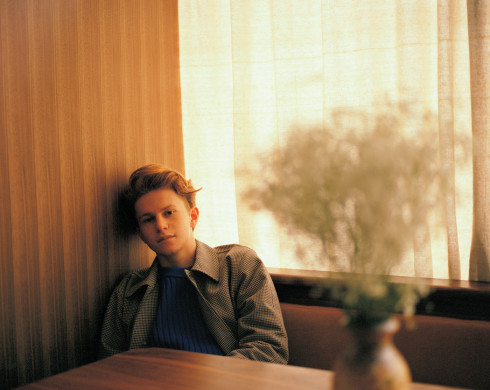PERLA
New York dining is at its finest when a restaurant achieves a certain harmony with the neighborhood that surrounds it. For Gabriel Stulman, whose foursome of West Village high points—Joseph Leonard, Jeffrey’s Grocery, Fedora, and, most recently, Perla—this quality has come about by way of an inverse process: the neighborhood itself has been informally renamed Little Wisco, in homage to his Midwestern touch. Alike in their commitment to combining classic preparation with an overtly contemporary twist, the restaurants are celebrated by a merry band of followers that includes high-minded critics and the creative branch of twenty- and thirty-somethings who prefer life south of Union Square.
Perla, which opened some four months ago on Minetta Lane, matches and then steps beyond the capabilities of its predecessors. Here, Stulman and executive chef Michael Toscano display a proclivity for modernizing rustic Italian cuisine without overreaching for something “nouveau”—a sometimes trite and overworn label for a menu that feels, in the end, like a hodgepodge. Both the setting and the dishes at Perla are shaped around a dialogue that first confronts and then absorbs you, a process that unveils itself anywhere creativity is in evidence. Even the walls bearing family portraits, a Stulman touch in a restaurant named for his grandmother, also house prints of Ol’ Dirty Bastard and other hip-hop contemporaries. Beneath their stare, diners and bar patrons spill toward the entrance at early as 7:00 PM, circled endlessly by casually-dressed servers kept afloat by Jay-Z’s staccato rhymes.
These ingredients blend with unexpected perfection, and they’re at their best when you don’t expect them to. But where Stulman and Toscano really hush the skeptics is in culinary execution—the decor isn’t intended to mask the taste. Though French-trained, Toscano found his passion in Italian fare by way of Mario Batali, first at Babbo and then Eataly’s Manzo, where focus on a single quality unveiled its value to him. “My mentality in creating dishes is that, whenever it’s on the plate, it should appear simple,” he explains. “But when you taste it, I want you to think, ‘Wow, how did they make this so flavorful? How did they make this so good?’ And it’s all the things we do behind the scenes.” While a traditionalist by trade, he commits to the belief that a menu must shape and be shaped by its surroundings. Perla, where cocktails carry names like Please Don’t Come Back From the Moon and Meet Me Tonight in Laredo, would inch by day-by-day in midtown, he argues, while it thrives in the West Village, where quality and imagination are of equal value.
The outcome is a rotating selection of dishes that might, in the hands of a team less capable, collapse under their own weight. The duck ragù, a crowd favorite, comes to life with a grated layer of foie gras terrine, sitting loftily atop handmade cavatelli. In the equally-praised roast guinea hen, the foie gras returns in a the form of sagu with a layer of black trumpet mushrooms. On the heavier side, beef tongue, born of Toscano’s commitment to utilizing any and all components of the animal, comes charred and piled high—the sort of dish that fares well in a five-stage menu when coupled with a softer start. To that end, try the braised octopus paired with oven dried tomatoes, eggplant, and fettunta, or the asparagus with mousseron mushrooms. Then, move toward a midcourse of spaghetti with rock shrimp or the well-executed gnocchi, layered with a refreshingly simple tomato sauce and ricotta.
Toscano’s praise of simplicity would seem disparaging with these dishes in mind, but Perla’s density is tempered by intermediaries. There’s the homemade chips all’amatriciana, peppered with chile flakes, or Toscano’s unique play on peanut butter and jelly: pistachio butter, cherry jam, and—why not?—foie gras. Cocktails like the Tombstone Sunday Night, which boasts a cinnamon-infused buffalo trace bourbon and pepperoni bitters, pair well with their meatier counterparts (they do, after all, nearly share ingredients). The wine menu, while impressive, is slightly less playful, with a selection of compartmentalized reds and whites—Italian, French, light, medium, and full, for ease of use—and the option to order, en masse, by theme.
Assuming, during your wait, you’re able to reach the bar, give the cocktail menu a thorough read. You’ll find what is perhaps the most outright demonstration of Stulman’s commitment to a choreographed experience. “A great book. A great song. A great way to climb to an evening,” reads the description of one drink, reminding us that a meal should take the shape of a crescendo, a steady climb upward punctuated by contents that fit within some experimental, albeit mildly accessible, form. On their end, Toscano says, the staff will work to make each successive visit one episode in a greater narrative, not unlike Stulman’s still-burgeoning career. “We’re only four months old,” Toscano reminds us. “We’re getting to a point where we’re really comfortable and could really meet our potential. We’re just trying to get better every day.”
Perla is now open at 24 Minetta Lane. Photography by Henry Hargreaves.

















